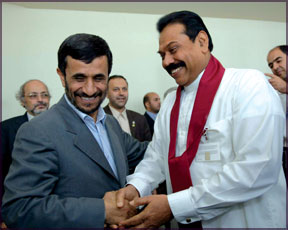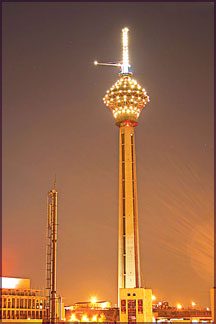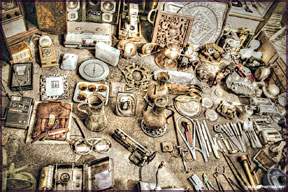Towards a powerful and bright future
by Dhaneshi Yatawara
[email protected]
Sri Lanka, since ancient times, holds a unique position in the middle
of international sea routes crossing the Indian Ocean.

According to old and new historians this central position of the
country was favourable to Persian, Indian, Ethiopian traders and their
ships as a resting position.
These traders as well as global-trotters had a great impact on the
Sri Lankan people and their culture and religion, the history testifies.
In this background, Iranians originally being Persians did have trade
ties with our island nation or ‘Serendib’ as the Arabian traders called
our land.
Though Iran is an Islamic country it is wellknown that its origins
are not Arabic but Persian. Historians believe that part of the Sri
Lankan architecture,town planning, irrigation, most of the arts and
crafts were gifts from the Persians. Ancient history bears evidence to
the fact that Iran had a kingdom that was spread to many parts of the
world.
|

The Milad Tower |
Historical facts, legends and mythical stories have proven this fact,
experts have stated.
It is believed that the ancient Sri Lankan irrigation technology was
highly influenced by Iran. Both countries show many similarities in this
technology and the written history of Sri Lanka bears testimony to the
fact that our irrigation system existed even before the arrival of
Mahinda Thera to spread Buddhism in Sri Lanka during king
Dewanampiyathissa era.
Considering trade ties between the two countries, Sri Lankan imports
to Iran mainly comprised precious gems, herbs and spices. Rubies have
topped the list. Iranian hand-woven carpets are internationally
acclaimed and some are kept in major museums of the world. Handicrafts
of Iran are the most durable and the most expensive in the world.

The Iranian-Sri Lankan relationship is not just one of those
historical epic stories. It is still alive. President Mahinda
Rajapaksa’s visit to Iran during November 2007 is a fine example for
this historical bond between the two countries.
And of course, the Iranian President Mohamoud Ahmadinejad’s visit to
Sri Lanka is significant in the context of these aspects.
The present Islamic Republic of Iran is the neighbour of Armenia,
Azerbaijan and Turkmenistan in the North, Afghanistan and Pakistan in
the East, Persian Gulf and Oman Sea in the South and Iraq, Turkey in the
West. Iran was known as Persia till 1935.
|

A shot taken in the Friday bazaar |
Iran’s total border area is 5,170 kilometres and with water 2510 km.
Iran has a dry climate. The Annual average rainfall is 275 mm and its
average temperature is 25 Centigrade degrees.
The population of Iran is approximately 62 million (2000) out of
which 98% are Muslims and the remaining 2% are Christians and
Zoroastrians. About half of the population is below the age of 20. More
than 60% of the people are living in urban areas and the remaining
portion in the rural areas.
Ethnic Diversity
Iran is one of the most ancient countries of the planet. Throughout
the years, its culture had its impact on different parts of the globe -
from the Nile River to the heart of Europe. It is the land where rings
of Asian, European and African civilisations are interconnected.
|

Turkaman handicrafts |
Iran’s unique demographical feature is its ethnical diversity. For
over 2,500 years people of Aryan origin, in particular, the Persians
co-existed peacefully in Iran. Each of the ethnic groups of today’s
Iran, such as the Persians, the Kurds, the Lors, the Azaris and the
Baluchies, speak their own dialects.
The official religion of Iran is Islam with more than 99 percent of
the population being Muslims. Zoroastrianism, Christianity and Judaism
are also officially recognised in the country. Their adherents are
privileged with the same civil rights as Muslims. Each of the official
religious group has a selected representative at the Parliament.
Iran is the second oil-producing country in the world and is blessed
with vast god-given energy resources. In addition to oil, Iran possesses
considerable mineral reserves. Development of mines has shown a
considerable growth in the past few years and has found a place in
Iran’s non-oil exports.
|

Snow clad Damavand |
The agro and industrial sectors are the driving forces behind Iran’s
economic growth while the country’s main source of revenue is energy.
Iran exports hand-woven carpets, caviar and dates, one of the best in
the world market. Iran also has active steel and copper production
industries.
The sandy coastal areas of the region are unique in the Middle
Eastern landscape. The thickest woods are also found in this area.
Caviar, a delicious delicacy is the product of this region.
Iran can be considered as a bridge linking East and West and also the
centre of the Silk Road.
The visit to Iran
President Mahinda Rajapaksa during the historical visit to the
Islamic Republic of Iran succeeded in entering into several agreements a
favourable to Sri Lanka.
|

Uma Oya in Sri Lanka |
Discussions were also held on such matters as narrowing Sri
Lanka-Iran trade deficit, grant of US$ 700 million to modernize
Sapugaskanda oil refinery, on interest free loans for import of fuel and
consolidating bilateral relation between the two countries that dates
back to the 10th Century.
Presidential Secretariat stated that during the course of this
discussions it was pointed out that 50% of fuel needs of Sri Lanka is
imported from Iran whilst US$ 50 million worth of tea is exported to
Iran and as such it was decided to increase the export volume of tea and
other commodities so that Sri Lanka could get a better return.
Iran also granted a massive financial assistance for the development
programmes of oil refineries, irrigation schemes and Uma Oya project in
Sri Lanka.
Eight Memoranda of Understanding (MoUs) were signed between the two
countries on:
* Maritime Merchant Shipping
* A bilateral Agreement on mutual administrative assistance for the
proper application of customs law and prevention, investigation and
combating custom offences,
* The construction of Uma Oya multi-purpose development project,
* Expansion of oil refinery capacity,
* Media cooperation between the Sri Lanka Ministry of Mass Media and
Information and the Islamic Republic of Iran Broadcasting,
* Facilitating financial and technical cooperation between the Sri
Lanka Board of Investment and the Mostazafan Foundation of Iran,
* MoU between Iranian Chamber of Commerce, Industry and Mines and the
Federation of Chambers of Commerce and Industry of Sri Lanka,
* MoU between the Iranian Chambers of Commerce, Industry and Mines
and the National Chamber of Commerce of Sri Lanka.
Accordingly the total amount of financial assistance to Sri Lanka
would be US$ 1.5 billion, Presidential Secretariat stated.
Uma Oya project
On April 29, Iranian President Mohamoud Ahmadinejad and President
Mahinda Rajapaksa will ceremonially inaugurate the Uma Oya Multi-Purpose
Development Project in Wellawaya.
The project envisages the construction of two dams - one across the
Uma oya at Puhulpola and the other across Mathotilla Oya at Diyaraba
estate.
This will divert 200 mega cubic meters of water annually from the
combined catchments of 350 sq. km to Kirindi Oya via 3.2 meters wide and
23 km long tunnel Uma Oya to Alikote Aru.
The proposed hydropower station is expected to make a contribution of
100 megawatts to the national grid.The Iranian Government is providing
US$ 450 million for the project as a soft loan under concessionary
terms. The project is expected to irrigate nearly 13,000 hectares.
Expanding the oil refinery
It is expected to increase the daily production capacity of 50,000
barrels of crude oil to 150,000 barrels of refined oil. A total of US$
700 million is granted for the project.
Steps taken by our Government to consolidate bilateral relations with
the Islamic Republic of Iran would herald a brighter future for our
island nation.
|
